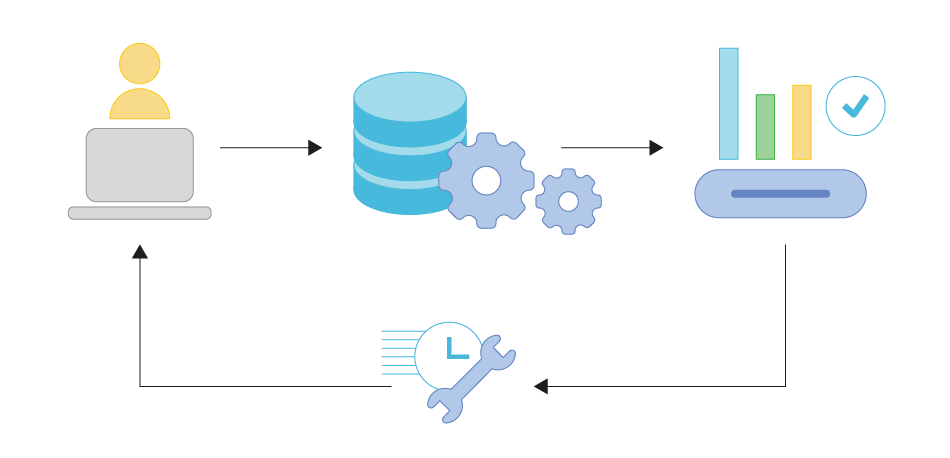Real Time Data FAQs
What is Real Time Data?
What does real time data mean? Real time data is information that is captured, processed, and available instantly or near-instantly upon its creation.
Real time data systems often involve technologies that allow for rapid data processing and transmission and enable quick responses and actions.
How is Real Time Data Collected
Organizations collect real time data through various methods and technologies designed to capture information as it is generated:
Sensors and Internet of Things (IoT) devices. These are embedded in equipment, machinery, infrastructure, or wearable devices to gather and transmit temperature, movement, location, and other data continuously or at regular intervals.
Web tracking and analytics. Websites and online platforms use tools like Google Analytics to track user behavior, page views, click-through rates, and other metrics in real-time.
Social media monitoring. Tools track mentions, hashtags, and conversations across social media platforms to gather real-time insights into public sentiment, trends, and brand mentions.
Mobile apps. Apps may collect and analyze user data in real time, including location, usage patterns, preferences, and interactions, for insights.
Machine learning (ML) and AI algorithms. These systems process incoming data streams to detect patterns or predict outcomes in real time, in contexts such as fraud prevention or anomaly detection.
APIs and data streams. Organizations utilize application programming interfaces (APIs) to access real time data from external sources. Examples include weather APIs and financial market data platforms.
Cloud-based solutions. These real-time data processing and storage capabilities allow organizations to handle large volumes of data streams and perform analytics on demand.
Distributed systems and edge computing. Edge devices and distributed systems process data closer to the source, reducing latency and enabling real-time decision-making.
Customer feedback tools. Real-time feedback tools, like surveys or live chat, help gather immediate insights from customers about products, services, or experiences and make it easy and painless for customers to participate.
Data aggregation and visualization tools. Platforms and tools that aggregate data from various sources and present it in real time through dashboards, enabling quick analysis and decision-making.
Example: How is Real Time Traffic Data Collected
Take the example of real-time traffic data. Users often deploy a combination of real time data collection technologies and techniques to gather information about traffic conditions:
- Sensors and detectors. Magnetic sensors embedded in pavement detect vehicles passing over them and measure traffic flow, speed, and density.
- Cameras. CCTV cameras or specialized traffic cameras capture visual data that is then processed to determine traffic flow, congestion, and incidents.
- GPS and mobile apps. Data from GPS devices in vehicles or mobile apps like Google Maps, Waze, or dedicated traffic monitoring apps provide real-time data on traffic conditions by tracking device movement and speed.
- Connected vehicles. Modern, connected vehicles can transmit data about their speed, location, and traffic conditions, contributing to real-time traffic data.
Crowdsourced platforms. These collect reports from users about road conditions, accidents, or delays contribute to real time data through user-generated information.
What is Real Time Data Analytics?
Real-time data analytics uses continuous or streaming data to assess information as it is collected to trigger responses or otherwise alert users in real-time. This kind of collection and real time data analysis is essential for things like social media and trading stock.
Real time big data analytics involves processing and analyzing vast, diverse datasets immediately as they are generated in real- or near real-time to derive insights from them without significant processing delays. This type of analytics deals with the challenges of handling enormous amounts of data at high velocities, often from various sources such as sensors, social media, and IoT devices.
Real-time big data analytics typically involves:
- Streaming data processing. Technologies like Apache Kafka, Apache Flink, or Apache Spark Streaming are commonly used to continuously ingest, process, and analyze data streams as they are generated.
- Complex event processing (CEP) engines. These identify patterns, trends, or significant events within data streams in real time to detect and respond to patterns rapidly.
- ML and AI. ML algorithms perform predictive analytics or anomaly detection in real time, for immediate insights and automated actions based on incoming data.
- In-memory computing. Technologies that store and process data in-memory achieve faster data processing speeds, crucial for real-time analytics.
What is Real Time Data Processing?
Real-time data processing involves handling data immediately as it’s generated or received, without any significant delay. This allows for the continuous analysis, transformation, and utilization of data as it flows through a system.
Here are some key steps in real time data processing:
Real time data ingestion. Various sources such as sensors, applications, databases, and streaming platforms capture structured, semi-structured, or unstructured data with data ingestion tools or frameworks and bring it into the processing system.
Data streaming or messaging. After ingestion, technologies that enable the continuous flow of data like Apache Kafka, RabbitMQ, or Amazon Kinesis are commonly used to transmit real time data as data streams or messages.
Real time data integration and processing. Initially, stream processing frameworks like Apache Flink, Apache Storm, or Spark Streaming apply techniques like filtering, enrichment, and normalization to extract valuable information from the data streams. Then, aggregation and transformation of the data from diverse sources into a unified and consistent view in real or near real time ensures the integrated information remains current and up-to-date. Key aspects of real-time data integration ensures that data from multiple sources is available in a unified, standardized/normalized format.
Real time data visualization and action. Based on the insights gained from the real-time analytics, actions can be triggered automatically or presented to users for decision-making. This step might involve triggering alerts, updating dashboards, or initiating automated responses based on predefined real time data visualization rules.
Real Time Data Use Cases
There are many use cases for real time data:
Weather prediction/disaster recovery. The United States Geological Survey (USGS) uses real-time data in a number of critical ways. For example, USGS scientists use real time data visualization to depict current wildfire risk and ongoing conditions. They also use machine learning, AI with real time data, and other tools to plot and model hazards from natural disasters like hurricanes.
Real-time supply chain and logistics management. Real-time data allows for greater visibility in tracking of shipments, inventory, and vehicles. It also enhances analysis of current market trends, consumer behavior, and demand forecasting, reducing excess inventory or shortages.
Using real-time data on traffic conditions, weather, sales, warehouse stock, production, and other factors, logistics companies can optimize delivery routes, choose the most efficient transportation modes, and reduce delivery times. They can also adjust inventory levels to prevent stockouts or overstock situations and help identify and address disruptions in the supply chain.
Real-time, 360-degree customer experience management. Real-time customer data helps organizations understand customer behavior, preferences, and interactions across different channels. This information allows companies to personalize interactions in real time, offering tailored recommendations, dynamic offers and promotions, or customer service responses.
Real-time data makes continuous monitoring of customer sentiment and perception possible, guiding businesses in making necessary adjustments to improve the overall experience. It also supports a consistent omnichannel experience and immediate issue resolution for enhanced customer satisfaction and loyalty.
Using AI real time data to boost sales. Companies leverage AI and real-time data in several ways to boost sales, including:
- Using AI-powered chatbots to provide instant, personalized concierge assistance to customers
- AI algorithms analyze real-time data to make predictions:
- potential leads most likely to convert
- future sales trends and demand patterns to anticipate market changes, adjust inventory levels, and plan marketing strategies
- smart trend prediction and more accurate forecasting
- Analysis of real-time customer data to provide personalized product recommendations
- Analysis of real-time data from social media, customer reviews and feedback to understand customer sentiment
- Offer personalized customer interactions and prompt customer service solutions
- Automated sales processes restore focus on high-value activities and agile sales strategies
- Real-time market data supports dynamic pricing
- Instant sales and performance metrics with insights
Financial trading. Real-time data is crucial for stock trading, where even a slight delay can result in significant harm. Traders rely on real-time market data for immediate decision-making.
Telecommunications. Network managers use real-time data to detect and address issues like network congestion, service disruptions, or security threats promptly.
Healthcare monitoring. Continuous monitoring of patient data in real time enables healthcare professionals to track vital signs, detect anomalies, and respond swiftly to critical situations.
Smart cities. Real time data from various sensors and IoT devices supports traffic management, public transportation, optimized energy usage, and public safety services. Real time data recovery helps ensure that cities stay online and in service even under dire circumstances.
Manufacturing. Real-time data helps monitor equipment performance, predict maintenance needs, and optimize production processes to reduce downtime and enhance efficiency.
Online advertising. Bidding relies on immediate data analysis based on real time data usage, online behavior, and other preferences for targeted delivery of ads.
Gaming and entertainment. Real time data drives interactive gaming and entertainment apps, adapting content and experiences based on user actions in the moment.
Best Database for Real Time Data
Several types of real time data collection systems and tools are well-suited for handling real time data services efficiently:
Time-series databases. These databases are ideal for handling time-stamped data, such as real-time data from sensors, IoT devices, and logs. Examples include Prometheus, KairosDB, InfluxDB and TimescaleDB.
NoSQL databases. NoSQL databases such as ScyllaDB, Cassandra, or DynamoDB offer scalability and flexibility, enabling rapid data ingestion and retrieval for real-time applications.
Stream processing platforms. Real time data collection tools like Apache Kafka, Amazon Kinesis, and Apache Flink are designed specifically to handle continuous streams of data, making them essential for real-time data processing and ingestion.
In-memory databases. Databases that store data in memory, such as Redis or Apache Ignite, offer fast read and write capabilities for smaller amounts of real-time data processing.
Graph databases. For real-time analysis of complex relationships between data points, graph databases (like Neo4j) that handle interconnected data are suitable.
Does ScyllaDB Offer Solutions for Real Time Data?
Yes. ScyllaDB is a high-performance distributed database designed to handle real-time data with low-latency. ScyllaDB is compatible with Apache Cassandra—but it delivers better performance and resource utilization along with low latency and a robust ability to handle high-throughput workloads. It is also compatible with DynamoDB–but its costs are 5-40X lower with up to fourX better P99 latency.
ScyllaDB’s architecture allows it to scale both vertically as well as horizontally across multiple nodes, ensuring data availability and performance for real-time data processing and analytics. This makes it an ideal real time data platform for various applications including IoT devices, financial services, auctions, and online gaming.
Learn more about ScyllaDB’s real time data resources and use cases.

